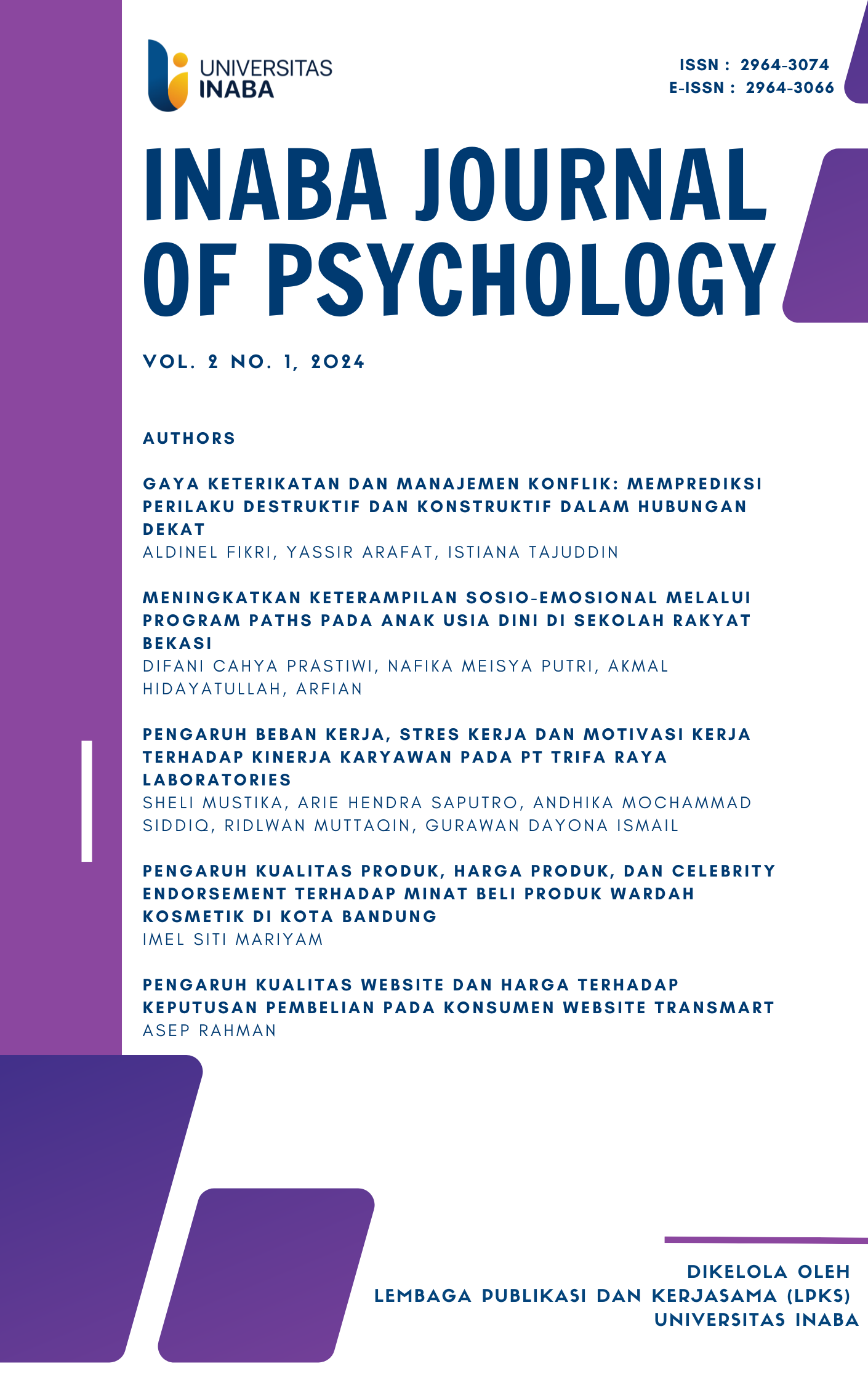Gaya Keterikatan dan Manajemen Konflik: Memprediksi Perilaku Destruktif dan Konstruktif dalam Hubungan Dekat
DOI:
https://doi.org/10.56956/ijop.v2i1.392Keywords:
Gaya keterikatan, strategi resolusi konflik, hubungan dekatAbstract
Strategi pasangan dalam menangani dan menyelesaikan konflik secara efektif berperan penting dalam upaya untuk memelihara hubungan yang sehat. Penelitian ini bertujuan untuk mengetahui peran attachment style (anxiety dan avoidance) terhadap strategi penyelesaian konflik dalam hubungan dekat yang ditinjau berdasarkan 4 karakteristik penyelesaian konflik, yaitu exit, neglect, voice, dan loyalty. Sebanyak 352 individu berpartisipasi dalam penelitian ini, terdiri dari 227 wanita (64,4%) dan 125 pria (35,5%) berusia antara 17 hingga 52 tahun yang sedang menjalin hubungan dekat atau sudah menikah. Hasil analisis regresi berganda menunjukkan bahwa anxiety dan avoidance memiliki peran yang variatif dalam memprediksi strategi penyelesaian konflik. Jenis kelamin juga memiliki efek prediktif secara khusus pada sub-dimensi loyalty. Sedangkan, status hubungan diketahui tidak memiliki implikasi yang signifikan terhadap masing-masing sub-dimensi yang terdapat ada variabel strategi penyelesaian konflik
References
Ben-Naim, S., Einav, M., Laslo-Roth, R., & Margalit, M. (2017). Hope in the family: individual differences in parenting stress, personal resources and coping. INDIVIDUAL DIFFERENCES, ROLE IN RECOVERY AND IMPACT ON EMOTIONAL HEALTH, 19.
Bonache, H., Gonzalez-Mendez, R., & Krahé, B. (2017). Romantic attachment, conflict resolution styles, and teen dating violence victimization. Journal of youth and adolescence, 46, 1905-1917.
Bonache, H., Gonzalez-Mendez, R., & Krahé, B. (2019). Adult attachment styles, destructive conflict resolution, and the experience of intimate partner violence. Journal of interpersonal violence, 34(2), 287-309.
Bradbury, T., Rogge, R., & Lawrence, E. (2016). Reconsidering the role of conflict in marriage. In Couples in conflict (pp. 59-81). Routledge.
Burrel, N., Allen, M., Mae, B., & Preiss, R. (2014). Managing interpersonal conflict. New York: Routledge.
Çaglayan, Z., & Körük, S. (2022). The Predictive Role of Self-Esteem, Attachment Styles, and Family of Origin Functions in Explaining Conflict Resolution in Romantic Relationships. International Journal of Contemporary Educational Research, 9(3), 557-568.
Civilotti, C., Dennis, J. L., Acquadro Maran, D., & Margola, D. (2021). When love just ends: An investigation of the relationship between dysfunctional behaviors, attachment styles, gender, and education shortly after a relationship dissolution. Frontiers in psychology, 12, 662237.
Cohen, J., Cohen, P., West, S. G., & Aiken, L. S. (2013). Applied multiple regression/correlation analysis for the behavioral sciences. Routledge.
Cohen, L., Manion, L., & Morrison, K. (2017). Mixed methods research. In Research methods in education (pp. 31-50). Routledge.
Corcoran, K. O. C., & Mallinckrodt, B. (2000). Adult attachment, self‐efficacy, perspective taking, and conflict resolution. Journal of Counseling & Development, 78(4), 473-483.
Creasey, G. (2002). Associations between working models of attachment and conflict management behavior in romantic couples. Journal of counseling Psychology, 49(3), 365.
Crowley, A. K. (2010). The relationship of adult attachment style and interactive conflict styles to marital satisfaction (Doctoral dissertation, Texas A & M University).
Domingue, R., & Mollen, D. (2009). Attachment and conflict communication in adult romantic relationships. Journal of Social and Personal Relationships, 26(5), 678-696.
Dutton, D. G., & White, K. R. (2012). Attachment insecurity and intimate partner violence. Aggression and violent behavior, 17(5), 475-481.
Feeney, J., & Fitzgerald, J. (2019). Attachment, conflict and relationship quality: Laboratory-based and clinical insights. Current opinion in psychology, 25, 127-131.
Fowler, C., & Dillow, M. R. (2011). Attachment dimensions and the four horsemen of the apocalypse. Communication Research Reports, 28(1), 16-26.
Fraley, R. C., & Shaver, P. R. (2000). Adult romantic attachment: Theoretical developments, emerging controversies, and unanswered questions. Review of general psychology, 4(2), 132-154.
Graber, E. C., Laurenceau, J. P., Miga, E., Chango, J., & Coan, J. (2011). Conflict and love: predicting newlywed marital outcomes from two interaction contexts. Journal of Family Psychology, 25(4), 541.
Hicks, D. (2021). Dignity: Its essential role in resolving conflict. Yale University Press.
Igbo, H. I., Grace, A. R., & Christiana, E. O. (2015). Relationship between duration of marriage, personality trait, gender and conflict resolution strategies of spouses. Procedia-Social and Behavioral Sciences, 190, 490-496.
Johnson, K. (2005). Examining the relationship satisfaction of mothers returning to work or study: The impact of attachment, commitment and conflict. Available from: researchbank. swinburne. edu. au.
Loureto, G. D. L., Gouveia, V. V., da Fonsêca, P. N., Gonçalves, M. P., dos Santos, W. S., Monteiro, R. P., & Freires, L. A. (2022). Predicting Responses to Conflicts in Romantic Relationships from Life History Strategies, Psychopathy, and Values. Evolutionary Psychological Science, 8(1), 10-19.
Maas, J., Laan, A., & Vingerhoets, A. (2010). Attachment, emotion regulation and adult crying. In Emotion regulation and well-being (pp. 181-195). New York, NY: Springer New York.
Mandal, E., & Lip, M. (2022). Mindfulness, relationship quality, and conflict resolution strategies used by partners in close relationships. Current Issues in Personality Psychology, 10(2), 135-146.
Mikulincer, M., & Shaver, P. R. (2012). Attachment theory expanded. In The Oxford handbook of personality and social psychology (p. 467). Oxford University Press.
Muris, P., Meesters, C., Morren, M., & Moorman, L. (2004). Anger and hostility in adolescents: Relationships with self-reported attachment style and perceived parental rearing styles. Journal of Psychosomatic Research, 57(3), 257-264.
Nyklíček, I., Vingerhoets, A. D., & Zeelenberg, M. (2011). Emotion regulation and well-being: A view from different angles (pp. 1-9). Springer New York.
Pietromonaco, P. R., Greenwood, D., & Barrett, L. F. (2004). Conflict in adult close relationships: An attachment perspective. Adult attachment: Theory, research, and clinical implications, 267-299.
Rusbult, C. E., & Zembrodt, I. M. (1983). Responses to dissatisfaction in romantic involvements: A multidimensional scaling analysis. Journal of experimental social psychology, 19(3), 274-293.
Rusbult, C. E., Verette, J., Whitney, G. A., Slovik, L. F., & Lipkus, I. (1991). Accommodation processes in close relationships: Theory and preliminary empirical evidence. Journal of Personality and social Psychology, 60(1), 53.
Shrestha, N. (2021). Factor analysis as a tool for survey analysis. American journal of Applied Mathematics and statistics, 9(1), 4-11.
Siegel, D. J. (2020). The developing mind: How relationships and the brain interact to shape who we are. Guilford Publications.
Somohano, V. C. (2013). Mindfulness, attachment style and conflict resolution behaviors in romantic relationships.
Tabachnick, B. G., Fidell, L. S., & Ullman, J. B. (2013). Using multivariate statistics (Vol. 6, pp. 497-516). Boston, MA: pearson.
Watson-Currie, E. (2004). Attachment, accommodation, and the outcomes of romantic relationships. University of Southern California.
Yildiz, B. (2023). Attachment, growth fear and conflict resolution in close relationships. International Journal of Psychology and Educational Studies, 10(2), 453-462.








